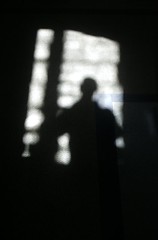umbre des escholes
Er unterschätzte die Gefahren romantischer Naturbetrachtung - He had underestimated the dangers of the romantic contemplation of nature (Die Katarakte) || Pausanias finally writes, "When I began to write my history, I was inclined to count these legends as foolishness; but on getting as far as Arcadia I grew to hold a more thoughtful view of them, which is this: in the days of old, those Greeks who were considered wise spoke their sayings not straight out but in riddles, and so the legends about Cronos I conjectured to be one sort of Greek wisdom." (Paul Veyne, Did the Greeks believe in their myths? Chicago: 1988, p.11) || Filicide, the violent bodily climax of paternal power which Freud has hidden from view in the three-card monte of the Oedipus complex, occurs in the climactic final scenes of The Earthquake of Chili, The Foundling, and, twice, in Die Familie Schroffenstein. (Silke-Maria Weineck, "Kleist and the Resurrection of the Father" in Eighteenth-Century Studies, 2003 (37:1), p.71) || When the present Duchess of Sutherland entertained Mrs. Beecher Stowe, authoress of “Uncle Tom’s Cabin,” with great magnificence in London to show her sympathy for the Negro slaves of the American republic — a sympathy that she prudently forgot, with her fellow-aristocrats, during the civil war, in which every “noble” English heart beat for the slave-owner — I gave in the New York Tribune the facts about the Sutherland slaves. (Epitomised in part by Carey in “The Slave Trade.” Philadelphia, 1853, pp. 203, 204.) My article was reprinted in a Scotch newspaper, and led to a pretty polemic between the latter and the sycophants of the Sutherlands. (K. Marx, Capital, Vol.1: Chapter Twenty-Seven: Expropriation of the Agricultural Population from the Land) || ...let us note only the great half-anthropological, half-cosmological analyses of Heinroth, which interpret madness as the manifestation in man of an obscure and aquatic element, a dark disorder, a moving chaos, the seed and death of all things [...] (M. Foucault, Madness and Civlization, Routledge, 1993, p.13) || Keyhole, it emerges, was made as a result of "a bunch of dreams I was having that have really been haunting me". "Melancholy dreams," he says, "where I revisit my past: dead relatives and homes that have meant a lot to me, particularly my childhood home. I can remember them far better in the dream than I can in waking hours." [...] For the past year or so, Maddin has been working on a film "seance" project called Hauntings (or Spiritismes, when it fetched up at the Pompidou in Paris earlier this year). The idea is that Maddin and his cohorts would "contact" the ghost of a lost film – William Wellman's Ladies of the Mob, for example, or Mikio Naruse's The Strength of a Moustache – and then recreate/reimagine it as if under the influence of the cosmic ectoplasm. (The Guardian) || Their most frequent reproach concerned Pasquier's habit of giving too many references to the sources he cited. This procedure, they told him, cast a "scholastic pall" ("umbre des escholes") on the book and was unbecoming in a work of history. (P. Veyne, Did the Greeks believe in their myths? Chicago: 1988, pp.5-6)


<< Home